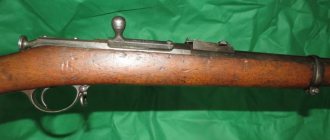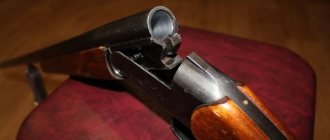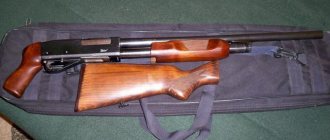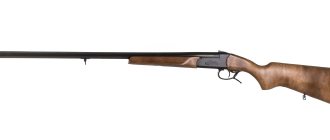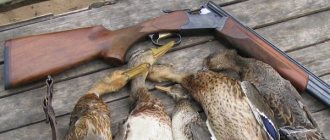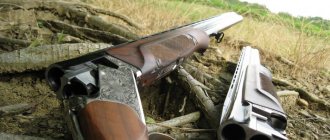It is almost impossible to fulfill the desire to purchase a universal weapon suitable for hunting small game, birds and large animals. Experienced hunters advise having several types of guns . 32 caliber barrels are unpopular among hunters. It is believed that they are more difficult to hit game and are unsuitable for long-range shooting. Beginning hunters prefer larger calibers, which are more likely to kill a bird or animal. However, many professional hunters have 32 and 28 calibers . They believe that such guns are optimal for commercial hunting for furs and birds when using medium-sized shot numbers.
History of appearance in Russia
In the second half of the 19th century, there was a real disorder in the Russian army in terms of the types of firearms in service. The soldiers used rifles from different manufacturers, firing different calibers of ammunition. This situation did not suit the command, so it was decided to send two officers to the United States - A.P. Gorlov and K.I. Gunius, in order to study the American arms market and select a single model of small arms for the Russian army.
As a result of a long study of various types of rifles and shotguns, the officers came across Heirem Berdan. His rifle seemed to Gorlov and Gunius to be an ideal option - it had high combat characteristics and had a fairly simple design. But the officers did not want to bring a crude sample of rifled weapons to Russia. Therefore, it was decided to modify Berdan’s brainchild to suit the needs of the Russian army. As a result, the total number of design changes reached 35, and the weapon began to be called the “Berdan rifle No. 1.”
The new model entered service with the Russian army in 1871. As weapons spread among military personnel, the armory was busy modernizing the existing version, as well as releasing new versions. In 1877, not only the infantry, but also the grenadier (artillery) and dragoon (cavalry) corps were re-equipped with a rifle. The Berdan rifle was in service with the Russian army until the legendary Mosin rifle appeared in 1891.
How the rifle works
Let us pay attention to the principle of operation of the sliding shutter, revolutionary for those years (1870). It serves to open and close the barrel and moves in a box located on the axis of the barrel
The handle is connected to the extractor and the hammer. The movement of the handle from left to right locks the barrel, sends the cartridge into the chamber and at the same time serves to cock the firing pin, while the reverse movement leads to the ejection of the cartridge or spent cartridge case.
This design is not ideal and has been subject to justifiable criticism. Thus, the small stroke of the handle - only 45 degrees - could cause accidental opening of the bolt, which led to injuries among careless and inattentive shooters, this happened especially often in worn-out samples.
Serious disadvantages include cocking the hammer, which is illogically connected with the movement of the bolt handle: not with the initial blow on it, but directly related to the movement back and forth. This decision was the reason for installing a weak mainspring, and because of it, misfires occurred in severe frosts, when the force of the firing pin was simply not enough to pierce the cartridge primer.
Despite the listed disadvantages, the Berdanka was superior in accuracy to almost all other analogs existing at that time, only slightly inferior to the British Martin-Henry design, and the production price, ease of learning and practical rate of fire were decisive arguments when discussing the feasibility of adopting it for service.
Design and mechanism
The Berdanka, which was put into service in 1871, compared to modern rifles, has a number of disadvantages and inconveniences (large weight and dimensions, lack of an extractor, not a very successful cartridge) that are associated with the design of the weapon. In order to shoot and reload the model, it was necessary to perform many actions:
- Pull the key pipe back using the special shank.
- Open the bolt slightly using the ball-shaped handle.
- Insert ammunition into the chamber.
- Return the bolt and key tube to their original position.
- Fire a shot.
- Open the bolt again and release the spent cartridge case.
However, over time, modifications of the Berdanka began to appear, equipped with a sliding bolt, which greatly simplified the process of operating the rifle - the new system itself sent the chamber into the cartridge, and the spent cartridge case was ejected under the action of an extractor when opened.
The rifle stock, which was originally made of hazel, deserves special mention, and over time was replaced by a version made of birch. On the wooden part under the barrel there was a special mount intended for installing a bayonet. And two sliding rings located on the butt and under the barrel made it possible to equip the weapon with a belt so that a soldier could carry it on his shoulder.
Design features
The Berdan-2 rifle was equipped with a frame sight designed for a maximum firing range of six hundred steps. Her front sight without a muzzle was located at a considerable distance from the muzzle. And on the right side of the barrel there was a boss intended for attaching a bayonet, and a stock with a straight neck. The Berdanka was equipped with a bayonet.
The design of the rifle was extremely simple. Its trigger mechanism with a mainspring and firing pin were located inside the locking tube, which, together with the bolt, which hinged on the transverse axis, worked quite smoothly. The rifle was not equipped with an extractor: soldiers had to remove spent cartridges only by hand. Therefore, while surpassing its contemporaries in accuracy and accuracy of shooting, in terms of convenience it was inferior to some other models.
The Berdan-2 rifle had the same stock as on the first release. At first it was made from walnut, and then from birch. The forend was fastened to the barrel with sliding rings on screws. There were two of them. The sighting devices also had the same design, and the lug for attaching the bayonet remained on the right side. At the same time, the bayonet was modified. It was not attached under the barrel, but on the right.
The bolt was locked by turning it by forty-five degrees. This was clearly not enough for such a large-caliber weapon firing a powerful cartridge. In this case, the comb with which the bolt of the Berdan rifle was equipped rested against the rear wall of the receiver.
Options and modifications
Different units of the Russian army required different versions of weapons. For example, the cavalry could not use long and bulky rifles, sharpened for shooting from a long distance. This is how the dragoon version of the Berdan rifle No. 2 appeared, which has the following design features:
- significantly shortened barrel - the weapon was distinguished by less accuracy and firing range, but had enormous power;
- lack of a right mount for a bayonet - anyway, the dragoon rarely engaged in close combat, preferring to shoot from a distance of 30 to 70 meters ;
- reduced sight size - for a cavalryman it was important to have a wide viewing angle, and not a sight designed for long-range shooting;
- improved fastening of the stock rings (steel springs instead of screws) - made it possible not to worry about the belt coming off during a gallop;
- reduced powder charge - too much power produced more noise, which frightened the horse.
However, the dragoon version of Berdanka was not suitable for everyone. It especially did not suit the Cossacks, who also made up a significant part of the Russian army. As a result, a Cossack version of the weapon soon appeared, having the following features:
- an even lighter and shorter barrel;
- lack of safety bracket;
- replacing the trigger with a button.
The release of new modifications of Berdanka did not stop there. Following the Cossack rifle, based on the dragoon model, a hunting carbine was released, which was also used to arm light cavalry.
With the advent of the Mosin carbine, the Berdan rifle began to be gradually removed from service. For a long time, about 3 million weapons were simply collecting dust in warehouses (melting down a rifle with such a rich history seemed wasteful). However, with the advent of Soviet power, Berdanka began to appear again in the hands of soldiers - although only in the rear units. Well, since interest in the old model awoke again, in 1930 TOZ decided to start modifying the Berdanka, remaking the design for a smoothbore cartridge of 12, 16, 20, 24 and 32 calibers.
Specifications
Of course, compared to modern models of rifled weapons, the Berdan rifle does not have the best technical characteristics. However, many hunters prefer it not only as a respect for its rich history, but also simply because the carbine is well suited for hunting wild animals and shooting predators. Here are the characteristics of the Berdan rifle (model 1870):
| Characteristic: | Parameter: |
| Caliber | 10.75 (4.2 lines) |
| Cartridge | 10.75x58R |
| Barrel length | 830 mm |
| Overall length (excluding bayonet) | 1300 mm |
| Rate of fire | 8 rounds per minute |
| Initial bullet speed | 437 m/sec |
| Sighting range | 1000 meters |
| Weight | 4.2 kg |
The accuracy of the Berdanka is not very impressive: when fired from a distance of 100 meters, the spread varies from 5 to 7 centimeters . However, this characteristic was increased in modified versions, as were some other aspects mentioned.
Hunting berdanks
After the Berdan rifle was removed from service with the Russian army, the weapon still continued to be in educational institutions as a training carbine for shooting or hand-to-hand combat. However, most of the Berdanoks were coated with preservative lubricant, packed and sent to the mobilization reserve. Only at the beginning of the 20th century were arms factories allowed to convert rifles into hunting weapons. The Tula Arms Plant was the first to pick up the idea.
In just a few years, the arms market was filled with inexpensive, but fairly high-quality conversion products, which were available to almost every hunter. The price tag for Berdanka varied around 20 rubles, while the average salary for a worker was about 60 rubles. 10.75 caliber cartridges were also relatively inexpensive - a box of 100 pieces cost hunters only 6 rubles.
The price of the Berdan rifle jumped a little after the weapon was converted into a smoothbore and became known as the Frolovka. Such weapons were actively used for hunting game birds and fur-bearing animals, and also had great potential for modernization. The maximum caliber of hunting frolovkas was twelfth (18.5 mm), but most often Russian hunters bought the universal 16th caliber (16.8 mm).
Decline of a rifle's military career
It would seem that after several million copies of Berdanoks were written off, their disposal was only a matter of time. However, the legendary rifle again had to take part in the Second World War. Although the front-line soldiers were still not armed with Berdanka, since at that time there were already many modified models of the three-line rifle (Mosin rifle). But among the rear people, weapons were very widespread.
Despite the fact that the weapon was decommissioned long ago and was more than half a century old, it proved its worth during the defense of important strategic points. Berdanka demonstrated its high potential, so bush producers became interested in it. However, the carbine was not used in wars again - this was the end of his military career.
Handicraft production
The production and sale of homemade Berdankas began even before the First World War. However, it was after the weapon again showed its potential in combat that bush manufacturers began to mass produce modifications of the old rifle. The most popular were the 16, 16, 28 and 32 caliber frolovkas. Manufacturers tried not only to improve their technical characteristics, but also to change their appearance. To do this, a layer of nickel was applied to the metal, as well as decoration in the form of engraving or stamp. On the arms market you can still find many homemade Berdan rifles, which are real works of art.
Berdanka-Frolovka 32 caliber.
Factory assemblies of the gun
The main manufacturer of frolovkas based on Berdanka was the Tula Arms Plant. The company even organized a special workshop that was engaged in drilling out old models and casting new smoothbore barrels of the following calibers:
- 12 (18.5 mm);
- 16 (16.8 mm);
- 20 (15.6 mm);
- 24 (14.7 mm);
- 28 (13.8 mm);
- 32 (12.7 mm).
The most popular calibers were considered the 16th and 20th, since they were best suited to the needs of the Russian hunter. Smaller versions - 28 and 32 calibers - were mainly produced to order. Twenty-four was considered a real rarity and was produced mainly in one-piece versions. Well, the 12th gauge began to appear a little later than the others, when America imposed on Russia the fashion for hunting with this particular cartridge.
Also, few people know that TOZ at one time produced several Berdan rifles using the 44-caliber cartridge (Winchester) for firing. However, there were so few such rifles that now almost no one mentions them.
Advantages of 32 caliber barrels
The technical and design characteristics of the entire range of small-caliber weapons differ slightly. At the same time, 32-caliber weapons in some cases turn out to be more practical and convenient:
- Light weight . At first glance, a difference of several hundred grams is not decisive. However, hunters who travel dozens of kilometers in search of prey have a completely different opinion. The barrel, which is light in weight, can be carried in your hands for a long time and be ready at any time for the sudden appearance of game.
- Less recoil and less tiring sound for the hunter . This is valuable in situations where a series of shots must be fired, such as when hunting migratory birds. Unpleasant sensations, or even bruises in the shoulder area, can ruin the pleasure and cause significant discomfort.
- Appropriateness . An important factor for hunting a moving target. The gun is immediately placed with the back of the butt towards the shoulder, and the barrels are pointed in the direction of aiming. Often this happens automatically, and the hunter himself believes that he is only “throwing” the gun in the direction of the game (shooting “on the side”). Stock weapons do not require adjustments, reduce shooting time and increase effectiveness. However, this is a subjective factor and depends on the specific shooter, his physique, shooting style and even clothing. Ideal accuracy is when, when raising the weapon, the aiming line passes exactly through the aiming point.
- Good accuracy . Especially if you load it with 0000 shot, which in the cartridge fits 4 pieces in 4 rows. It is worth remembering that small-caliber guns are more sensitive to defects and errors in drilling bores and material defects than large-caliber ones. Therefore, it is necessary to pay special attention to the drilling and the condition of the barrel metal. It is believed that the best barrels are those with choke drilling.
- Covers a large area . This is valuable when shooting fast moving game and birds.
- Optimal for fur farming . When shooting at a fur-bearing animal, damage to the skin is minimal, which is especially important for small game.
- Economical . Ready-made cartridges cost at least slightly, but are still cheaper than for large-caliber weapons. When loading independently, when the hunter finds the optimal weights of powder charge and projectile for his weapon, the benefits become more obvious.
- Less weight of cartridges . A filled cartridge belt weighs less, and you can take more ammunition with you. Relevant for hunters who travel long distances in the forest or in cases where it takes a long time to get to the hunting site.
- Convenience . The gun is compact and reliable, the barrel length is short. This is valuable if you need to make your way through thickets or through a swamp. It is easy to handle in warm winter clothes. This increases the shooter's mobility.
Berdanki in our time
Many modern hunters and connoisseurs of the classics are concerned about the question of whether it is possible to purchase a Berdan rifle at the present time. Unfortunately, such relics are quite rare for sale. You can find them only in thrift stores or from current owners (there is no point in looking in gun stores). However, you should prepare for the fact that such a model will cost a hefty sum, because its age is almost 150 years. Many collectors even believe that purchasing a Berdanka can be compared to investing in antiques.
Nowadays, Berdanka is a real treasure for connoisseurs of antiques.
The Berdanka is a rather old weapon that is unlikely to surprise a modern hunter with its technical characteristics. Berdan's system is very outdated, so using it to hunt animals is also not very convenient. However, the weapon has a huge advantage over modern rifled carbines - a rich history. The rifle had to take part in two world wars, as well as countless conflicts during the existence of the Russian Empire. So Berdanka should be regarded as nothing more than a relic that needs to be protected and passed on from generation to generation. If you have such a weapon, then you are very lucky.
